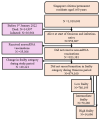Real-World Effectiveness of Boosting Against Omicron Hospitalization in Older Adults, Stratified by Frailty
- PMID: 40573896
- PMCID: PMC12197443
- DOI: 10.3390/vaccines13060565
Real-World Effectiveness of Boosting Against Omicron Hospitalization in Older Adults, Stratified by Frailty
Abstract
Background/objectives: Older adults with frailty are at-risk of worse outcomes following respiratory-viral-infections such as COVID-19. Data on effectiveness of vaccination/boosting in frail older adults during Omicron is lacking.
Methods: National healthcare-claims data and COVID-19 registries were utilized to enroll a cohort of older Singaporeans (≥60 years) as of 1 January 2022, divided into low/intermediate/high-risk for frailty; matching weights were utilized to adjust for sociodemographic differences/vaccination uptake at enrolment across frailty categories. Competing-risk-regression (Fine-Gray) taking death as a competing risk, with matching weights applied, was utilized to compare risks of COVID-19-related hospitalizations and severe COVID-19 across frailty levels (low/intermediate/high-risk), with estimates stratified by booster status. Individuals were followed up until study end-date (20 December 2023).
Results: 874,160 older adults were included during Omicron-predominant transmission; ~10% had intermediate/high-frailty-risk. Risk of hospitalization/severe COVID-19 was elevated in those with intermediate/high-frailty-risk up to XBB/JN.1 transmission. Boosting was associated with decreased risk of COVID-19-related hospitalization across all frailty categories in infection-naïve individuals. However, in infection-naïve older adults with high-frailty-risk, while receipt of first boosters was associated with lower risk of COVID-19-hospitalization/severe COVID-19, additional booster doses did not reduce risk. In reinfected older adults, first boosters were still associated with lower hospitalization risk (adjusted-hazards-ratio, aHR = 0.55, 95% CI = 0.33-0.92) among the non-frail, but not in the intermediate/high-frailty-risk minority.
Conclusions: First boosters were associated with reduced adverse COVID-19 outcomes across all frailty categories in infection-naïve older adults during Omicron. However, in the high-frailty minority, boosting did not additionally reduce risk in reinfected individuals with hybrid immunity, and beyond the first booster for infection-naïve individuals.
Keywords: Omicron; SARS-CoV-2; boosting; frailty; geriatrics; vaccination.
Conflict of interest statement
The authors declare no conflicts of interest.
Figures



Similar articles
-
Measures implemented in the school setting to contain the COVID-19 pandemic.Cochrane Database Syst Rev. 2022 Jan 17;1(1):CD015029. doi: 10.1002/14651858.CD015029. Cochrane Database Syst Rev. 2022. Update in: Cochrane Database Syst Rev. 2024 May 2;5:CD015029. doi: 10.1002/14651858.CD015029.pub2. PMID: 35037252 Free PMC article. Updated.
-
Nirmatrelvir combined with ritonavir for preventing and treating COVID-19.Cochrane Database Syst Rev. 2023 Nov 30;11(11):CD015395. doi: 10.1002/14651858.CD015395.pub3. Cochrane Database Syst Rev. 2023. PMID: 38032024 Free PMC article.
-
Signs and symptoms to determine if a patient presenting in primary care or hospital outpatient settings has COVID-19.Cochrane Database Syst Rev. 2022 May 20;5(5):CD013665. doi: 10.1002/14651858.CD013665.pub3. Cochrane Database Syst Rev. 2022. PMID: 35593186 Free PMC article.
-
Comprehensive Geriatric Assessment for community-dwelling, high-risk, frail, older people.Cochrane Database Syst Rev. 2022 May 6;5(5):CD012705. doi: 10.1002/14651858.CD012705.pub2. Cochrane Database Syst Rev. 2022. PMID: 35521829 Free PMC article.
-
Rapid, point-of-care antigen tests for diagnosis of SARS-CoV-2 infection.Cochrane Database Syst Rev. 2022 Jul 22;7(7):CD013705. doi: 10.1002/14651858.CD013705.pub3. Cochrane Database Syst Rev. 2022. PMID: 35866452 Free PMC article.
References
-
- Makovski T.T., Ghattas J., Monnier-Besnard S., Cavillot L., Ambrožová M., Vašinová B., Feteira-Santos R., Bezzegh P., Bollmann F.P., Cottam J., et al. Multimorbidity and frailty are associated with poorer SARS-CoV-2-related outcomes: Systematic review of population-based studies. Aging Clin. Exp. Res. 2024;36:40. doi: 10.1007/s40520-023-02685-4. - DOI - PMC - PubMed
-
- van Raaij B.F.M., Noordam R., Smits R.A.L., van der Klei V.M.G.T.H., Jansen S.W.M., van der Linden C.M.J., Polinder-Bos H.A., Minnema J., Tap L., van der Bol J.M., et al. Preparing for future pandemics: Frailty associates with mortality in hospitalized older people during the entire COVID-19 pandemic, a Dutch multicentre cohort study. Eur. Geriatr. Med. 2024 doi: 10.1007/s41999-024-01001-1. ahead of print . - DOI - PMC - PubMed
-
- Kojima N., Adams K., Self W.H., Gaglani M., McNeal T., Ghamande S., Steingrub J.S., Shapiro N.I., Duggal A., Busse L.W., et al. Investigating Respiratory Viruses in the Acutely Ill (IVY) Network. Changing Severity and Epidemiology of Adults Hospitalized With Coronavirus Disease 2019 (COVID-19) in the United States After Introduction of COVID-19 Vaccines, March 2021–August 2022. Clin. Infect. Dis. 2023;77:547–557. doi: 10.1093/cid/ciad276. - DOI - PMC - PubMed
LinkOut - more resources
Full Text Sources
Miscellaneous

